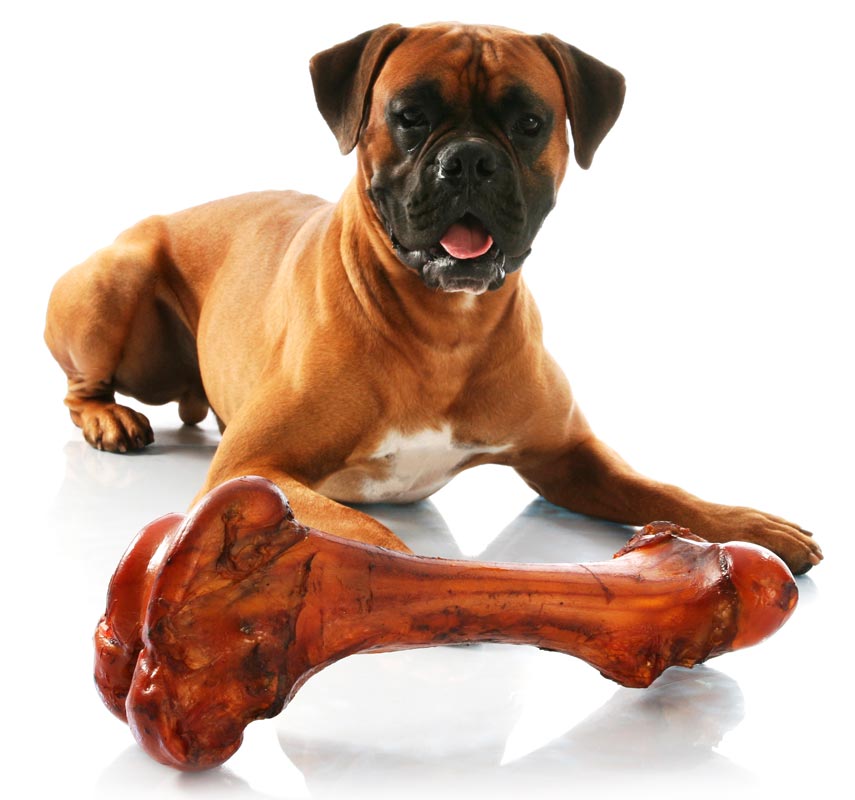Dogs and Bones

We’re all familiar with the storybook image of a dog chewing a bone. Omnivorous scavengers that they are, dogs find bones hard to resist. Their incredibly strong jaws are perfectly adapted to gnaw through the tough cortex to get to the ultimate treat: the delicious fatty marrow inside.
The practice of feeding bones to dogs definitely has its proponents. It seems like a perfectly natural treat, one that canines crave. Gnawing bones and comparable products (such as cow hooves, deer antlers, and rawhide) provides healthful exercise, an outlet for pent-up energy. Some claim that chewing bones may improve a dog’s dental health—not to mention the breath—by removing harmful plaque and food residue. The controversial “Bones And Raw Food (BARF)” diet has many avid proponents. Wild dogs have consumed bones for ages. Why shouldn’t our modern canines enjoy this primordial treat?
Dogs may like bones, but bones don’t always like them. The fact your dog may have always eaten bones doesn’t negate the risk. We don’t know how many wild canines suffer complications from eating bones, but any veterinarian will tell you that pet dogs occasionally do. The following are risks and complications of eating bones:
Dental injury. Bones, just like rocks or any other hard substance, can grind down the teeth, causing chronic wear. Bones can easily break a dog’s teeth too. The most commonly fractured teeth are a dog’s eyeteeth and the carnassial, the large upper molar on either side of a dog’s jaw. Fractures to the carnassial tooth are easy to miss, can be quite painful to the dog, and expensive to treat.
Oral injury. Small poultry bones (particularly once cooked) can splinter and cause scrapes and ulcers of the gums, lips, and tongue. Large round steak bones, if they’re just the right size, can become lodged between the eyeteeth, causing a very unpleasant situation for your dog.
Choking. Bone splinters or chunks of just the right size can become lodged in an unlucky dog’s airway. This is a life-threatening emergency.
Foreign body. While dogs are famous for their iron stomachs, even the hardiest digestive tract is no match for a healthy chunk of beef or pork bone. A bone stuck in the tummy can cause chronic vomiting and loss of appetite. Small splinters can cause constipation, ulcers, and bleeding as they pass through the colon. Most dangerous is the piece that lodges in the small intestine, causing a life-threatening emergency. Intestinal rupture, sepsis, and even death can result.
Tummy troubles. Short of the above calamities, the trace ingredients in a bone can be enough to make things go haywire. If your dog is allergic to pork, for instance, then an hour or two with a ham-hock is sure to send his intestines into turmoil. Not to mention that raw, untreated bones can carry unpleasant organisms like E. coli and Salmonella and cause what amounts to food poisoning in your dog.
The fact remains that dogs just love to chew. And admittedly, most people have thrown their dog a bone at one time or another with no ill effect whatsoever. Some people swear by bones as a mainstay of their dogs’ diet. What is a responsible dog companion to do?
- First, consider a safer alternative. There are countless specialized chew toys on the market that can provide your dog similar satisfaction without the risk of a real bone. Look for a firm, but not hard, synthetic bone that’s appropriately sized for your pet. If it’s flavor your dog craves, try a Buster Food Cube or Kong that can be stuffed with peanut butter or another yummy treat.
- If it’s healthier teeth you’re after, then several preferred options exist. Brushing your dog’s teeth daily, and/or feeding specialized dental diets and treats, along with professional veterinary dental care, are the best ways to maintain those pearly whites. The Veterinary Oral Health Care (VOHC) website has a useful list of clinically proven dental products for pets. For the best advice for your own dog, consult your veterinarian.
Finally, if you still think it’s worth the risk, bone up on these safety tips first:
- Always supervise your dog when she is chewing a bone. Interrupt her to remove any small chunks or splinters that break off. If you notice she’s gobbling the bone rather than patiently gnawing, maybe it’s time to switch to something else.
- Avoid food leftovers. Cooked bones typically are harder and more brittle. Cooked poultry bones can splinter dangerously, whereas cooked beef bones may harden and pose a greater risk for broken teeth.
- Discard bones that have become small enough to be swallowed. The bone should be appropriately sized to your dog’s mouth.
- Consult your veterinarian. Vets can have widely varying opinions about this topic. Check with your own veterinarian for a personal recommendation that’s best for your dog.
No bones about it.
You May Also Like These Articles:
How to Make Your Car a Safe Place for Your Dog
FDA Cautions Care with Use of Osurnia and Claro
Dr. Google: Helpful or Dangerous?
Is Giving Ice or Ice Water to Dogs Dangerous?
How to Tell If Your Dog Needs a Sweater
A General Guide to Puppy Safety
Disclaimer: This website is not intended to replace professional consultation, diagnosis, or treatment by a licensed veterinarian. If you require any veterinary related advice, contact your veterinarian promptly. Information at DogHealth.com is exclusively of a general reference nature. Do not disregard veterinary advice or delay treatment as a result of accessing information at this site. Just Answer is an external service not affiliated with DogHealth.com.
Notice: Ask-a-Vet is an affiliated service for those who wish to speak with a veterinary professional about their pet's specific condition. Initially, a bot will ask questions to determine the general nature of your concern. Then, you will be transferred to a human. There is a charge for the service if you choose to connect to a veterinarian. Ask-a-Vet is not manned by the staff or owners of DogHealth.com, and the advice given should not delay or replace a visit to your veterinarian.



